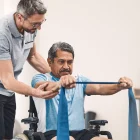Synopsis
Fractures can cause significant disruption in daily life, but with the help of after fracture physiotherapy, patients can recover more quickly and regain full mobility. This blog explores the essential role of physio for a broken ankle, physiotherapy for tibia fracture, and how fracture physiotherapy treatment aids recovery. We’ll also discuss the importance of physiotherapy for humerus fracture and how manual therapy, combined with physio exercises for bone fractures, ensures a complete and safe recovery. Discover how bone fracture physiotherapy can help you regain strength and mobility while preventing long-term complications.
Table of Contents
- Why Physiotherapy is Crucial After a Fracture
- Physiotherapy for Ankle Fractures- Restoring Strength and Mobility
- Tibia Fracture Physiotherapy- Rebuilding Leg Strength
- Physiotherapy for Humerus Fractures- Restoring Shoulder and Arm Function
- Manual Therapy for Fracture Recovery
- Strengthening Exercises for Bone Fracture Recovery
- The Role of Balance Training in Fracture Rehabilitation
- Orthocure’s Approach to Fracture Physiotherapy
- Conclusion- Long-Term Benefits of Physiotherapy for Fracture Recovery
Why Physiotherapy is Crucial After a Fracture
Shoulder pain can arise from various causes, including overuse, rotator cuff injuries, frozen shoulder, and bursitis. Left untreated, these conditions can result in chronic discomfort and limited mobility. Physiotherapy for shoulder pain focuses on restoring strength, flexibility, and movement in the shoulder joint. By addressing the underlying cause of the pain, physiotherapists help patients regain function and prevent future injuries. Through a combination of manual therapy, exercises, and posture correction, physiotherapy provides lasting relief from shoulder pain.
Physiotherapy for Ankle Fractures- Restoring Strength and Mobility
Ankle fractures are common injuries that can occur during sports, accidents, or falls. Physio for a broken ankle focuses on restoring mobility, improving balance, and rebuilding strength in the ankle joint. After the initial healing phase, patients begin gentle range-of-motion exercises, followed by strengthening and balance training to improve stability. Physiotherapy helps patients recover faster and reduces the risk of future ankle injuries.
Tibia Fracture Physiotherapy- Rebuilding Leg Strength
The tibia, or shinbone, is a critical part of the lower leg, and fractures to this bone can severely limit walking and movement. Physiotherapy for tibia fractures helps patients regain strength and function in the leg through a structured rehabilitation plan. Strengthening exercises focus on the muscles supporting the tibia, while mobility exercises improve flexibility in the knee and ankle joints. Regular physiotherapy sessions ensure that patients recover quickly and avoid complications like muscle atrophy or joint stiffness.
Physiotherapy for Humerus Fractures- Restoring Shoulder and Arm Function
Humerus fractures, which involve the upper arm bone, can limit shoulder and arm movement. Physiotherapy for humerus fracture includes exercises that target the shoulder joint and surrounding muscles to restore full arm mobility. Passive range-of-motion exercises are often introduced early to reduce stiffness, followed by strengthening exercises to improve muscle function and joint stability. Manual therapy may also be used to relieve pain and improve flexibility in the shoulder.
Manual Therapy for Fracture Recovery
Manual therapy is an essential part of fracture physiotherapy treatment. Techniques like joint mobilization, massage, and soft tissue manipulation help improve circulation, reduce stiffness, and promote tissue healing. By applying manual therapy, physiotherapists can alleviate pain and improve the range of motion in the affected joints, ensuring a smoother recovery. Regular manual therapy sessions, combined with strengthening exercises, help patients regain full mobility and prevent long-term stiffness.
Once the bone has healed, strengthening exercises are crucial for restoring the muscles surrounding the fracture site. Physio exercises for bone fractures focus on improving muscle strength, balance, and coordination. Exercises such as leg presses, lunges, and resistance band exercises are commonly used to rebuild strength in the lower body after a tibia or ankle fracture. For humerus fractures, exercises like shoulder presses and arm curls help strengthen the upper body. Regular strengthening exercises ensure that the patient regains full function and can return to daily activities safely.
The Role of Balance Training in Fracture Rehabilitation
Fractures, particularly in the legs, can affect balance and coordination. Balance training is an important component of bone fracture physiotherapy because it helps patients regain their ability to walk and move confidently. Balance exercises such as standing on one leg, using a balance board, or dynamic stability drills are incorporated into physiotherapy plans to improve coordination and prevent falls. These exercises are essential for restoring the patient’s confidence and preventing re-injury.
Orthocure’s Approach to Fracture Physiotherapy
At Orthocure Clinics, we offer personalized fracture physiotherapy treatment to help patients recover quickly and safely from bone fractures. Our team of experienced physiotherapists uses a combination of manual therapy, strength-building exercises, and balance training to ensure that each patient regains full mobility and function. Whether you’re recovering from an ankle, tibia, or humerus fracture, we tailor our treatment plans to meet your specific needs and goals.
Conclusion- Long-Term Benefits of Physiotherapy for Fracture Recovery
In conclusion, physiotherapy for fractures is essential for ensuring a smooth recovery and preventing long-term complications. Through a combination of manual therapy, strengthening exercises, and balance training, patients can regain mobility, improve strength, and prevent future injuries. Working with a skilled physiotherapist ensures that the recovery process is tailored to the individual’s needs, promoting faster healing and better long-term outcomes.
What are the most effective physiotherapy techniques for fracture recovery?
Fracture physiotherapy treatment includes a combination of manual therapy, strengthening exercises, and balance training. Manual therapy helps reduce stiffness and improve circulation, while strengthening exercises target the muscles surrounding the fracture site to restore strength. Balance training improves coordination and stability, preventing falls and re-injury. These techniques work together to ensure a smooth recovery and full restoration of mobility.
How long does it take to recover from a fracture with physiotherapy?
The timeline for fracture recovery varies depending on the severity of the injury and the location of the fracture. For minor fractures, patients may begin to see improvements within a few weeks, while more severe fractures may require several months of physiotherapy. Regular physiotherapy sessions, combined with home exercises, are essential for achieving a full recovery and preventing complications such as stiffness or muscle weakness.
Can physiotherapy help with ankle fractures?
Yes, physio for a broken ankle is highly effective in restoring mobility and strength after an ankle fracture. Physiotherapists guide patients through a series of range-of-motion exercises, followed by strengthening and balance training. These exercises help rebuild stability in the ankle joint, reduce pain, and improve the patient’s ability to walk and move confidently. Regular physiotherapy sessions are essential for a successful recovery from ankle fractures.
How does physiotherapy help with humerus fractures?
Physiotherapy for humerus fracture focuses on restoring shoulder and arm function through a combination of manual therapy and strengthening exercises. Physiotherapists use passive range-of-motion exercises to reduce stiffness in the shoulder joint, followed by strengthening exercises to rebuild muscle function. These exercises help patients regain full use of their arm and shoulder, allowing them to return to their normal activities more quickly.
Why is balance training important in fracture rehabilitation?
Balance training is a critical part of bone fracture physiotherapy because fractures, particularly in the lower body, can affect coordination and stability. Balance exercises help retrain the body to maintain stability during movement, reducing the risk of falls and re-injury. By incorporating balance training into their physiotherapy program, patients can improve their confidence and regain full mobility more quickly.





